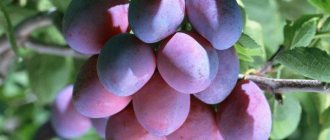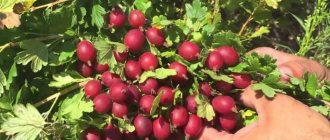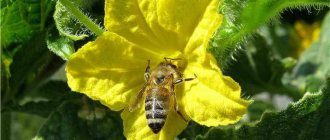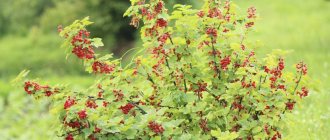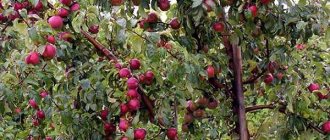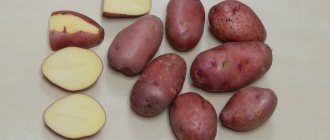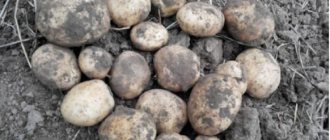Advantages and disadvantages
| Advantages | Flaws |
| • high marketability - pleasant taste, beautiful fruits, large bunches; • absence of seeds; • good yield, possibility of harvesting 2 times per season; • juiciness of berries; • frost resistance; • keeping quality; • early maturation; • bisexuality; • resistance to most diseases; • excellent transportability. | • sensitivity to precipitation; • tendency to rot; • susceptibility to wasps; • the need for rationing and tying of bunches. |
Plant care
For successful growth, grapes need careful care.
Having successfully planted a grape bush on a plot, there remains an equally important part of its care, including watering the plant, fertilizing, pruning and tying up the vines. A competent approach to each task will provide you with a generous harvest of sweet and aromatic berries.
Watering requirements
Grapes are a fairly drought-resistant crop, but at the same time they respond well to increased soil moisture. Therefore, in order to achieve maximum yield, the bushes must be watered in a timely manner. Water should be used at a warm temperature (20–25°C). The procedure is carried out in the evening or early morning. For irrigation, prepare holes 20 cm deep, which are dug at a distance of 30–40 cm from the bush. When the water is absorbed, these furrows are covered with earth, and the soil around the plant is loosened.
Important! During prolonged precipitation, autumn watering is not carried out; otherwise, the plant is moistened after harvesting, this will prevent deep freezing of the soil.
Table: order of watering grape bushes
| Regularity | Water consumption |
| At the budding stage | 40–50 l per 1 m2 |
| After flowering | |
| When growing and filling berries | |
| After harvesting the fruits |
Norms and rules for applying fertilizers
Fertilizing is an important stage in grape care
Grapes are an unpretentious plant and can grow on rocky soils. But at the same time, regular fertilizing has a positive effect on harvest volumes. They begin to fertilize the bushes from the third year after planting. Until this time, the plant has enough nutrients added to the pit. Fertilizers are added to the soil to a depth of 20–30 cm. To do this, dig a trench along the row, which is covered with soil after the procedure is completed.
Table: feeding grapes
| Period | Nutrient elements |
| In April | Dilute a bucket of cow manure and half a bucket of bird droppings in 40 liters of water and leave for a week, then dilute 1 liter of this mixture in 10 liters of water. Consumption - 10 l per bush |
| Before flowering | |
| After the flowers fall | 10 g of ammonium nitrate per 1 m2 |
| At the initial stage of fruit ripening | 30 g superphosphate, 20 g nitrophoska, 50 g ash per bucket of water |
| In September | Once every three years, when digging, you need to add 5–7 kg of dry cow manure |
Bush pruning
Pruning will allow you to form a productive bush
Pruning allows you to improve yields and also improve the quality of berries. This procedure helps to restrain the growth of grapes, which, without appropriate intervention, will spread to the walls of nearby buildings. Bushes are pruned in the fall, since during this period active processes in plants are suspended, making it easier for them to tolerate the removal of branches.
For bushes up to three years old, from three to eight sleeves are left annually, the rest are eliminated. Older plants are pruned in the following order:
- In early September, young shoots up to 50 cm long are harvested.
- For stems whose size reaches approximately 80 cm, the top is shortened by 10% of the length.
- After the leaves fall, the lower shoot growing from the outer side of the sleeve is cut off at a height of 3–4 buds, and the stem, which has the opposite location, is cut off at the level of 7–12 buds.
Video: pruning workshop
Features of the garter
It is recommended to tie grapes in a horizontal position
The grapes need garter. During the first two years, stakes are used for this purpose. Subsequently, special trellises are installed near the bush - pillars 2–2.5 m high and at least 10 cm thick. The distance from each other is 3 m. Then do the following:
- A wire with a cross section of 1.8–2.4 mm is pulled between the pillars in three rows at a level of 50 cm.
- The vines are tied with woven ribbons in a horizontal position or at an angle of 45°. If you attach it vertically, only the upper eyes will develop, and the lower ones may stop growing altogether .
- Before the winter period, 2–3 days after the first frost, the grapes are removed from the support and covered with agrofibre, film, burlap or sprinkled with a layer of damp soil 20–30 cm thick.
Video: master class on garter
History of appearance
“Veles” is a relatively young grape variety, the criteria for obtaining which were seedlessness, early ripening, mild taste and attractive presentation. The goal was achieved by the Ukrainian breeder from Zaporozhye Zagorulko V.V., when in 2009 he crossed grape varieties “Rusbol” and “Sofia”. The winegrower named his brainchild in honor of Veles, the god of fertility of the Slavs.
Parents of “Veles” are “Rusbol” and “Sofia”
Origin and zoning
This variety of crop was obtained in 2005 by Ukrainian amateur breeder V.V. Zagorulko. Bred by the method of generative hybridization of the popular Novocherkassk variety “Rusbol” and the hybrid form “Sofia” (his own selection).
Grape varieties that served as parent forms: “Rusbol” (left) and “Sofia” (right)
Since 2009, Veles, which has aroused great interest, has been actively studied both in commercial plantings and in private farms in the steppe and forest-steppe zones of Ukraine, as well as in experimental plantings at the Magarach Research Institute on the southern coast of Crimea.
The variety has not received official registration in the State Register of the Russian Federation, and there is also no reliable data on its licensing and certification in foreign sources.
Using the clonal improvement technique, Kuban specialists in the Krasnodar region isolated the clonal variety “Veles K” from the population of the Ukrainian variety “Veles”. After successful testing in the Central zone of Kuban in 2013, the clone variety was submitted for state testing in Russia and Ukraine as recommended for inclusion in the registers of plant varieties suitable for individual farmer and industrial cultivation in both countries.
Currently, thanks to a number of advantages, the original variety and its clone are successfully grown in summer cottages in many regions of Russia, Ukraine, Belarus and other neighboring countries.
You can get acquainted with the features of Veles in more detail from the video filmed by a Belarusian amateur winegrower:
Characteristics
Kishmish “Veles” belongs to the very early high-yielding table varieties.
Ripening period
The hybrid surpasses its “parents” in ripening speed - its growing season is only 95-110 days, so the first harvest is usually harvested in mid-July.
Reference! For the “Rusbol” variety this figure is 115-125 days, for the “Sofia” variety it is 110-125 days.
Moreover, in the southern regions the berries ripen about 3 weeks earlier than the specified period, in the northern regions - on the contrary.
Frost resistance
The variety is able to withstand short-term frosts, with a lower temperature threshold of -21°C. This is not enough for the grapes to survive the winter without shelter in the middle zone. In the southern regions, the vines tolerate the cold period normally, and even if damage occurs, they are restored within a year.
Bush
“Veles” is distinguished by its rapid growth, while its vines ripen at 90% of their length, which can reach 5-6 m per season. Its leaves are dark green, wide, glossy, medium in size with carved edges. The teeth on them are deep. The reverse side of the leaf plate is rough.
A distinctive feature of the variety is its lush flowering, during which large fused bisexual inflorescences are formed. This avoids problems with pollination, so the vines never “peat”.
Reference! For bushes, multi-arm fan or trellis pruning is preferable, which can be either on a high or low stem.
Bunches and berries
The clusters are large and voluminous. There are both conical ones with a wing and shapeless ones. They are moderately dense and loose. Their average length is 18 cm, but can reach 40-50 cm. The weight of each varies from 600 g to 5 kg.
The round or ellipsoidal berries of the variety are painted in a beautiful pink color, which resembles amber in the sun. Fetal parameters:
- Length - 1 -1.5 cm.
- Width - 1-1.2 cm.
- Weight - 5-10 g.
The skin of the fruit is thin but dense, so “Veles” tolerates transportation well over long distances. When chewing, the skin is not felt. The aroma and taste of the berries is distinctly nutmeg. The consistency of the pulp is similar to marmalade and slightly crunches when bitten.
Sugar content depends on the place of cultivation and is in the range of 18-20%. Acidity is low - no more than 9 g/l. The variety has class IV seedlessness: instead of full-fledged seeds, only their rudiments are formed in the berries.
Productivity
“Veles” ripens early, so it manages to produce 2 waves of harvest - in July-August and in October. Each vine produces 3-4 clusters. So, during the season, one bush produces 30-50 kg of berries, their quantity depends on the care and growing conditions.
Description of Veles grapes
Veles grapes are an early ripening hybrid variety. About 100 days pass from the appearance of the first leaves to the ripening of the fruits. The Veles grapevine grows and ripens quickly. One fruiting shoot forms 2-4 flower clusters. Flowers are bisexual. The plant does not need additional pollination, however, if you want to increase the yield, you can resort to artificial pollination.
As the crop ripens, stepsons form on the vine, which can produce an additional harvest by mid-September.
In the description of the Veles grape variety, the weight of a bunch of grapes is indicated from 600 g to 2 kg; according to reviews and photos of winegrowers, a bunch can ripen up to 3 kg. The shape of the Veles grape bunch is cone-shaped, very voluminous, not very dense or loose.
The berries are oval in shape, weighing up to 5 g, the skin is thin, but quite dense, does not allow the berries to crack, the color of the berries when the fruit is technically ripe is pink, only rudiments of the seeds remain - the rudiments of seeds, which are not felt when eaten.
Thanks to the thin skin of the Veles variety, the berries are visible in the sun, which makes them aesthetically attractive to the buyer. The pulp of the berries is dense, jelly-like, pleasant taste with a nutmeg tint.
Kishmish Veles grapes are a frost-resistant variety that can withstand temperatures down to -23°C. Suitable for central Russia if the plant is covered for the winter. In the southern regions it is possible to obtain 2 harvests.
Watch a video about Veles grapes:
Features of cultivation
The quantity and quality of the harvest depends on proper planting and care of grapes.
Kishmish “Veles” seedlings, as described, adapt quickly and well to a new site.
Soil and planting
The variety is not particularly demanding on the quality of the substrate, so planting can be done on:
- Sandstone.
- Sandstone.
- Loam.
- Clay soil.
- Chernozem.
- Rocky ground.
- Carbonate soil.
Reference! You cannot plant grapes in wetlands - the root system will suffocate.
When choosing the location of the vineyard, it is worth considering the depth of groundwater - it should be located at least 1.5 meters from the surface. It is better to give preference to sunny areas with good air movement.
It is recommended to plant grapes in the spring before the sap flow begins (in April-May), or in the fall - in October. In this case, the rows should be arranged from north to south, and young plants should be placed at a distance of 1.5-2 m from each other.
Recommendations for planting:
- The preferred pit size is 80x80x80 cm.
- There should be a drainage layer at the bottom.
- It is necessary to add organic matter to the soil - humus, peat or compost, as well as superphosphate, ash and potassium salt.
- It is recommended to make the soil level in the planting hole 35-40 cm lower than the surrounding soil - this will facilitate the process of covering the bushes for the winter.
- You should not plant Veles next to moisture-loving crops.
- After uprooting old plants, new ones can be planted in this place only after 3-4 years.
- After planting, the top layer of soil should be covered with mulch to prevent the appearance of weeds and slow down the evaporation of moisture.
Reference! When planting, it is better to immediately think about support.
Trimming
In the spring, pruning must be done before the sap begins to flow, otherwise there will be problems with wound healing. During the procedure, it is recommended to remove diseased, damaged, dried shoots and shorten the length of the remaining buds by 6-8. It is also permissible to carry out long pruning - the yield will not be affected if you leave 30-40 buds on the bush.
Correct garter of shoots
During the growing season, the vines should be tied up several times. This is necessary so that the shoots receive enough light and do not intertwine with each other - this way they grow stronger and the berries ripen faster.
The first garter to the trellis should be done when the vine reaches 30-40 cm. This can be done using twine, twine, knitted or textile tapes and special plastic clips. The shoots should be secured so that they are securely fixed, but not crushed. As the vine grows, it must be tied to the upper levels of the wire.
Reference! For “Veles” it is necessary to ration the bunches and inflorescences - remove every 3rd one so that the load on the bush is not excessive.
“Veles” is characterized by the formation of a large number of stepsons. It is on them that the second harvest is formed in the southern regions. Therefore, in regions with a warm climate, they need to be pinched, and where it is colder, completely removed so that they do not draw strength from the bush and thicken it.
When preparing plants for winter, you should cut off all the shoots, with the exception of 6 fruit-bearing vines - you need to leave 3 on each side.
Diseases and pests
The variety is characterized by average resistance to diseases. Therefore, it is important to carry out preventive examinations and treat bushes against mildew, oidium, gray rot and anthracnose.
| Disease | Signs | Treatment | Prevention |
| Mildew | oily spots and white coating on the leaves, they turn pale and fall off | spraying with fungicides (Rodomil, Strobi, Quadris, Thanos, etc.) | compliance with agricultural practices, regular inspections and spraying |
| Oidium | grayish-white coating on all parts of the bush, leaf curl | spraying with fungicides (colloidal sulfur, “Folcon”, “Strobi”, “Topaz”, etc.) | |
| Gray rot | wrinkling of fruits and the appearance of a grayish coating on them, rotting | removal of infected shoots, treatment with soda solution (70 g per 10 liters of water) | |
| Anthracnose | brownish-brown spots, fragility of shoots, falling leaves, drying out berries | removal of affected areas, spraying with copper oxychloride |
Phylloxera on grape leaves
Among the pests, the greatest danger to Veles are leaf rollers, spider mites and phylloxera.
| Parasite | Signs of appearance | Fighting methods | Prevention |
| Spider mite | thin white cobwebs, yellowing and falling leaves | at the beginning of spring treatment with the drug “DNOC”, at the end of summer - with “Phosphmid” | compliance with agricultural technology |
| leaf roller | appearance of caterpillars, rotting of berries, damage to leaves | spraying the bush and the soil underneath it with DNOC or another insecticide in early spring | |
| Phylloxera | swelling on the underside of leaf blades and roots, growth retardation | not treated, burning the bush that is the source of infection and plants within a radius of 30 m near it | “covering” the planting hole with fine-grained sand |
Wintering
“Veles” tolerates frosts in the middle zone well, but it requires shelter for the winter. It should be installed in the fall, when the temperature drops to -10-12ºС. There is no need to carry out this procedure earlier - light frosts are good for the bushes.
Reference! Young shoots react painfully to cold, so they need to be covered more carefully.
Option for covering grapes for the winter
The vines should not be left on the ground, so you need to prepare a substrate in advance - slate, boards, etc. Then the grapes must be trimmed, treated for diseases and parasites, and untied from the support. After which you need to cover the bushes first with straw or spruce branches, and then with film or agrofibre, securing the structure around the perimeter with bricks, boards or other heavy objects.
You can also build a protective structure for the grapes:
- Lay boards or slate on the ground.
- Prepare the grapes for wintering and untie them from the trellis.
- Cover with spruce branches or straw.
- Cover wooden panels with agrofibre.
- Install them in the form of a hut over the bushes.
This shelter can be used for several seasons.
Reference! In regions with warm climates, it is permissible to cover only the roots.
Storage
The clusters can be left on the branches for 1-1.5 months, provided that the weather is dry. During this time, the taste and aroma of the berries will become more intense. During harvesting, the clusters should be cut off along with the stalks, leaving about 10 cm of the vine.
The bunches can be stored hanging or placed in boxes in one layer.
In the room where the grapes are located, it is necessary to maintain a temperature of 0-5ºС and humidity in the region of 85-90%. Under these conditions, the berries will not lose their external and taste properties for 2-6 months.
Regions
Regions with a lot of sunny days are preferred for growing this variety. In Russia, the best “Veles” harvests are obtained in:
- Krasnodar region.
- Crimea.
- Chernozem region.
- Volga region.
However, the variety also has good reviews in the Moscow region: thanks to the short growing season, the berries have time to ripen before the onset of the first cold weather.
How to tie and pinion grapes
During the growing season, Veles grape shoots will need to be tied repeatedly to several rows of trellises. Why is tying shoots done?
- Crowding of leaves and shoots is reduced to nothing when the green mass shades each other without receiving enough sunlight;
- It makes it easier to carry out work on caring for the vineyard. It is much easier to carry out foliar fertilization, pinching and removing shoots from Veles;
- Shoots in a tied position grow strong and ripen faster;
- Tying grapes prevents diseases and improves ventilation of shoots and leaves.
When the shoots reach a size of 30-40 cm, they are tied in the lower trellis, then, as they grow, they are fixed to the next rows of wire.
The garter material can be twine, twine, scraps of textile or knitted fabric. It needs to be fixed securely, but with some margin, so that the growing shoot does not become overtightened in the future. Manufacturers offer winegrowers special plastic clips that are very convenient to use and designed for repeated use.
A feature of the Veles grape variety is its ability to form numerous second-order shoots. In the southern regions, a second harvest may well grow on them. But in the middle zone, a large number of shoots will only draw on the strength of the bush, preventing the crop from ripening quickly and shading the bush, which is a negative factor in the development of diseases. Therefore, the stepsons should be removed completely, and in the southern regions the upper part should be pinched.
Comparison with analogues
Let’s compare “Veles” with the most similar and popular seedless varieties.
| Sign | Variety | |||
| Veles | Kishmish radiata | Kishmish No. 342 (Hungarian) | Jupiter | |
| Ripening period | 95-110 days | 120-130 days | 110 – 115 days | 110 – 125 days |
| Frost resistance | up to -21°C | up to -15°C | -26C | -29C |
| Yield per bush | 30-50 kg | 30-50 kg | 20 kg | Up to 30 kg |
| Bunches | up to 5 kg | up to 1 kg | 300 – 500 g | 250 – 500 g |
| Taste | sweet, nutmeg | sweet with slight sourness, nutmeg | Nutmeg flavor | Notes of nutmeg and strawberry |
| Color | pinkish amber | dull pink with lilac tint | Green-golden | Dark blue |
| Disease resistance | average | low | High | Above average |
| Shelf life | up to 6 months | up to 6 months | 1 month | 3 – 4 months |
| Sugar content | 18-20% | 18-22% | 19-21% | 22% |
| Acidity | 7-9 g/l | 6.5-7.5 g/l | 6-8 g/l | 4 – 6 g/l |
The characteristics of the Veles variety make it attractive for cultivation not only in places with a warm climate, but also in central Russia. It is enough just to follow the basics of agricultural technology to get an excellent harvest.
Preparation of protective structures for grapes
The Veles variety tolerates the cold of the middle zone well. However, you will need to organize a shelter. To do this, in the fall, the grapes are removed from the trellis, trimmed, preventatively treated against diseases, and covered with film or agrofibre.
Pruning Veles grapes is an obligatory stage of plant care, which not only facilitates the wintering of plants, but also shapes the future harvest. For the Veles variety, it is recommended to trim 6-8 buds of each shoot. Typically, in the middle zone, pruning occurs at the end of October - beginning of November.
For more information about protecting grapes for the winter, watch the video:
You should not immediately organize a shelter. Until the temperature reaches -10°C-12°C. The first frosts are beneficial for Veles grapes, as they harden them and prepare them for lower temperatures.
Old bushes of the Veles variety tolerate winter frosts much more easily; a sharp drop in temperature is most destructive for young plants. They need to be covered most carefully. Grape shoots removed from the trellis should not lie on bare ground. A substrate is used between them. For example, slate sheets or boards.
Next, the top of the grapes is covered with spruce branches, straw, or simply covered with earth, taking it from the inter-row spaces. Combined protective structures for grapes are more effective. Example: having covered the plants with spruce branches, they stretch a film or agrofibre on top, securing them along the perimeter with bricks. Fallen snow will additionally insulate the structure.
Another example of a protective structure: wooden or plywood panels covered with agrofibre or polyethylene film. They are placed above the stacked vines of the Veles variety at an angle, in the form of a hut. The advantage of such shelters is their repeated use over several years.
Another way to cover Veles grapes for the winter. Special trenches are dug under the grapevines. Grapes removed from the trellis are placed in them and secured with metal hooks. Arcs are installed on top at intervals of 0.5 m. Covering material is pulled over the arches, which is fixed on the sides with bricks or pegs. While the weather is above zero or slightly below zero, the ends of the shelter are not covered. But as soon as the weather sets in with an air temperature of -8°C-10°C, the ends are securely closed.
Important! The arches must be made of strong material: metal or polypropylene, so that they can withstand fallen snow and not bend.
Photo
Photos and reviews of the sultana variety “Veles”:
Advantages and disadvantages
As gardeners note, Veles has many more advantages than disadvantages. What can be considered positive characteristics:
- lack of seeds in berries;
- high yield;
- excellent commercial properties;
- the ability to harvest twice per season when grown in a warm climate;
- frost resistance;
- long shelf life;
- possibility of self-pollination;
- resistance to transportation;
- rich pleasant taste.
- Root rotting due to excess water;
- sensitivity to precipitation;
- not the highest resistance to diseases and insects.
Expert opinion
Bilalov Rubin Rustamovich
Republic of Dagestan, Tabasaran region, winegrower, engaged in grape selection and hybridization since 1990
The hybrid form has excellent market conditions, as it ripens by August 1-4 in open ground, and lasts 1.5 months on the bushes. At the international competition Golden Bunch of Grapes in Simferopol in 2010, Veles received two gold medals: from the national and professional tasting commission.
Reviews
I love this variety - amazing taste, no seeds, thin skin. I’ve been growing it for myself for three years now. In August the berries are already ripe. Alexander, Krasnodar region
Due to the huge brushes it ripens unevenly. Last year, we didn’t wait until the lower berries arrived, so we took them off the bush. But, in general, the variety is good, the main thing is to spray it against diseases and parasites. Nikolay, Poltava
I love Veles, I have been growing only it for many years. I haven’t encountered mildew or oidium, maybe I was just lucky. I have another problem - sometimes the grapes take so long to ripen that they begin to rot. But I found a way out - I shorten them, and that’s how I save the harvest. Maria, Moscow region.
Productivity and ripening time
The plant produces its first signal harvest in the 2nd year after planting, marketable fruiting begins in the 4th - on average about 28-30 kg per bush.
According to the results of field tests in the natural conditions of the Zaporozhye region (planting scheme 3.0 × 2.0 m: when shoots are placed on a two-meter vertical single-plane trellis, leaving one fruit link on each arm, with a load of up to 13-15 overwintering buds) five-year-old plantings demonstrated a yield of 22-23.6 kg per plant or 36.7-39.3 t/ha.
When cultivating “Veles” in the agricultural enterprise “Zagorulko” (village Kamenskoye, Zaporozhye region), a yield of 39.3 t/ha was recorded
Removable maturity occurs 95-102 days after bud break . The berries are firmly held on the stalks. If the vine is overloaded, the ripening period increases by 10-20 days. The longer the clusters hang on the bush, the worse the quality of the fruit will be.
The taste and aroma are revealed in the last ten days of July - the first ten days of August. When carefully picked, the fruits do not spoil and are stored well in the refrigerator for more than 2 months. The thin skin weakly protects the juicy seedless pulp from damage. The berry can be easily injured during transportation, so the variety is recommended primarily for fresh consumption and drying.
The opinion of an experienced Ukrainian gardener about the yield potential can be found in the following video:
Morbidity and preventive measures
The Veles grapes have average resistance to major vine damage. For prevention purposes, it must be treated against mildew, oidium, and fungal diseases.
| Diseases | Sustainability |
| Downy mildew (mildew) | Average, 3 points |
| Oidium | Average, 3-4 points |
| Gray rot | Average, 3-4 points |
As already mentioned about this grape variety, Veles grapes are relatively resistant to the most common vine diseases. Most often, preventative spraying is sufficient to obtain a healthy harvest. For preventive purposes and for the treatment of oidium, the modern drug “Folkon” has proven itself well; the treatment with it is repeated once or twice: first, the drug is used immediately after bud break, and the treatment is repeated a second time after flowering.
Spraying with copper and iron sulfate preparations is effective against mildew and pests, both before and after covering the vine, and after each rain. Treatment is also carried out with the preparations “Bi-58” together with “Horus” at the stage of the first 4-6 leaves and with a mixture of “Ridomil Gold” with “Topaz” and “Aktelik” at the stage of the appearance of pea-sized berries.
Transportation and storage
Veles grapes should be stored in a well-ventilated, cool room. The storage temperature for grapes is 8-10 degrees. Shelf life can be up to 6 months. The advantage of this form is that it is stored without losing its external and taste characteristics.
When transporting over long distances, the brushes are placed in small boxes in one layer, as close to each other as possible.
How to plant
Let's find out all the important nuances of planting this wonderful plant. Spring is best suited for planting Veles. In this case, the cutting will have a whole long, warm summer ahead of it to adapt to new conditions, take root successfully, and begin active growth. Having hardened and strengthened, the seedling will be able to safely survive the winter. But the problem is that in the spring there are very few good strong cuttings, but in the fall there are simply “in bulk”.
Spring planting must be done from the end of March to the end of May - it all depends on the climatic conditions of your region. If return frosts are possible, then after planting the cuttings must be covered with film for some time. It will also be interesting to learn about how the Aleshenkin grapes are planted.
Video shows how to plant grapes correctly:
Autumn planting, despite the fact that there is a harsh winter ahead, is convenient because nurseries have a huge selection of high-quality cuttings. In addition, most young seedlings placed in the ground in the fall still survive the winter: it is only necessary to provide them with good shelter. After such hardening, the next year some gardeners are already seeing the first harvest of young grapes.
If you are planting a vineyard, leave a distance of one and a half meters between the bushes: Veles needs enough space and light.
Choose healthy and strong seedlings for planting: such specimens will be able to take root well and subsequently produce a bountiful harvest every year. Each seedling must be soaked in clean water a day or two before being placed in the ground. Dissolve potassium permanganate or root former in water to make the procedure more effective.
Prepare the bed in advance: dig up the soil, apply fertilizer, and dig holes 80 cm deep. Their width and length should be approximately the same parameters. These dimensions will help the roots of the seedling to fit comfortably, and a sufficient amount of fertile soil will fit at the bottom of the hole.
Place the seedling in the hole and carefully cover it with soil
Try to handle the roots carefully, as it is very important not to injure them. When pouring the soil, make sure that it lies tightly; no air pockets should be left.
Having buried the seedling halfway, water it with water to ensure compaction of the soil and remove any possible air cushions at the roots.
conclusions
- Veles is an early ripening grape variety that has no seeds.
- The culture is high in calories and sugar content. It is recommended for people with diseases of the cardiovascular system and decreased vitality.
- The yield of the hybrid reaches 10 kilograms of berries per bush . Large clusters weighing up to 2 kilograms are formed on the vine, which ripen in 100 days.
- The hybrid can be planted twice a year - in autumn and spring.
- Caring for the Veles hybrid involves watering the plant before flowering and when the berries are forming, periodically applying fertilizer and mulching the soil.
- In the spring, grapes are pruned in order to increase their fertility.
Pests and diseases
“Veles” is a variety that was bred relatively recently, and therefore susceptibility to various fungal diseases has not yet been studied.
But it has been established that the variety’s immunity to mildew and oidium is very high, about 3.5–4 points.
To prevent disease of the bushes, preventive spraying is carried out three times during the ripening period. For the best effect, spraying with herbicides should be selected specifically for each type of disease.
To protect against birds and wasps, it is recommended to cover the bunches in special mesh packaging, which can be purchased in specialized stores.
Methods of propagation of grapes
This grape variety can be propagated in two ways:
- By cuttings.
- Grafted or own-rooted seedlings.
Cuttings are harvested in the fall.
Root them in a container with water. If it is not possible to immediately place them in the soil, then they are stored in cool conditions until spring. Planted when the temperature is warm. Find out more about how to properly grow grapes from cuttings.
The vaccination is carried out as follows:
- Cut off the old bush, leaving 10 cm from the soil.
- Clean it thoroughly.
- Split the stump into 2 parts.
- The end of the scion cut with a wedge is inserted into it.
- Make a tight tie.
- Coat thoroughly with moistened clay.
Video: grape propagation
Planting and care
Veles grapes are highly dependent on the location's sunshine and good soil.
When planting, it is necessary to ensure protection from the north wind and access to sunlight most of the day. The best solution for this task is a house wall or fence.
To avoid spoilage and cracking of fruits, the soil should not be swampy. Sandy loam with the addition of black soil is best suited.
The distance between bushes should not be less than 1.5 meters. If planting is done along the wall of a building, then you need to retreat about 1 meter between the wall and the bush.
Watering the bush should not be done frequently, but during the growing season, flowers are blooming and berries are pouring, special attention should be paid to watering.
Grapes are pruned by removing 6–8 eyes. And be sure to cover it for the winter with a film on which you need to pour mulch.
